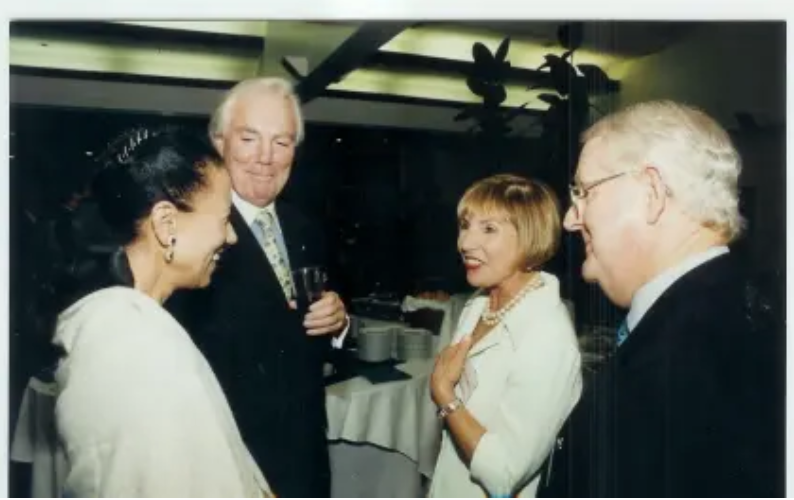How an Irish entrepreneur took the NZ Herald into a new era

In a guest column on the Gavin Ellis website Knightly Views, Michael Horton recalls how a former Irish rugby international entered the history of news media in New Zealand and closed an illustrious chapter during which the Wilson and Horton families had been at the forefront of the country’s newspaper production and the flagship New Zealand Herald.
Sir Anthony O’Reilly, who died on May 18 aged 88, was a brilliant man marked out for a lifetime of achievement which sadly ended following a succession of takeovers which drained his resources to the point of bankruptcy in 2015.
I first met Tony following a meeting in London with his manager during a world trip to locate a buyer for the 30 percent holding in Wilson & Horton held by Brierley Investments Ltd.
I had looked for a buyer unsuccessfully in Australia, the United States of America and London and was at the point of returning to New Zealand when I was invited to meet the chief executive of the Irish Independent, Liam Healy, in London in a Park Lane Hotel.
Finally, I had found a party really interested in New Zealand and with experience in newspapers, notably with the Irish Independent owned by the remarkable Tony O’Reilly, already well-known for his charm and sporting abilities seen by all New Zealanders during a tour of the British Lions in 1959.
Pictured above: Chryss Goulandris (left) and Tony O’Reilly with Rosie Horton and Liam Healy in Auckland.
In 1995 I flew to Dublin with my wife Rosemary Horton to continue the conversation and see how serious the offer was and continue these talks.
He had married Chryss Goulandris, from a famous Greek shipping dynasty. His beautiful castle-like home was set in park surroundings with the river Liffey meandering through the property known as Castlemartin.
He was at the point of wanting to expand his business interests in New Zealand, with which he was familiar from his rugby tours and continue his friendships with leading All Blacks with the Whineray family.
He could not have been presented with any better opportunity, with all newspapers still reaping the rewards of classified before the internet started to erode volumes by offering online transactions for cars and property etc. He talked about classified as “rivers of gold” as it was known as then but in fact the rivers were fading fast as internet sites became widely accepted.
He was fascinated by the success of Rupert Murdoch throughout England and Australia and saw Wilson and Horton as a breakthrough purchase for himself.
Arrangements went well and finally the Brierley executives were assigned to the task of merging Wilson and Horton with the overseas titles already owned by O’Reilly, particularly in South Africa.
We attended several social events at Castlemartin with many famous and successful people gladly enjoying the hospitality and Irish enthusiasm of Tony and Chryss at their charming manor house in the Irish countryside. Rosie was made most welcome and always a popular visitor.
Brierley Investments finally agreed on a price they were prepared to receive in exchange for the sale of their shares. They were an uncomfortable party for Wilson & Horton having seen the same company’s detrimental effect on the hugely successful New Zealand News public company, owners of many metropolitan papers, dailies and suburbans, and superb commercial printing assets in Auckland that were well ahead of their time. Brierley attempted a new morning daily for Auckland which quickly folded. They were demonstrably not publishers.
At Wilson and Horton, Tony O’Reilly decided that a management change was needed and appointed a senior executive of the company John Maasland, who was then manager of the Comprint enterprise in South Auckland. To assist the financing of the takeover at $9 a share, it was expected that several “non newspaper” subsidiaries would be sold, however that was not to be the case despite offers made to the new management and presumably the new board.
A Commonwealth Press conference was scheduled to be held in Capetown, South Africa. Already at the time, there had been changes in the political scene and white editors had to be replaced by native South Africans. This was an opportunity for us to meet other O’Reilly senior executives.
Tony had to have been impressed with the new printing facilities at Ellerslie which including the latest web offset presses made in Preston, Lancashire, and the automatic inserting bindery equipment from Ferag in Switzerland. Much of the financing for this had come from the timely sale of Reuter shares in London following their float on the London Stock Exchange and sale of Christchurch Press shares, well before the earthquake, to News Ltd
In contrast with the old and dated facilities in Dublin, the new Herald facilities would have been a giant step forward.
The saga of the ownership of the New Zealand Herald eventually ended in full takeover, passing to a subsidiary known as APN, and eventually under the ownership of NZME.
Republished from Knightly Views with permission from APMN committee member Gavin Ellis.
Post a reply